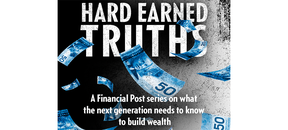Hard earned truth: Investors and savers beware that ‘we’re probably in a world that’s going to have higher inflation’

Article content
By Daina Lawrence
Article content
Article content
Inflation is easing back in line with historical levels, but one of the biggest mistake investors can make is to relax about how much of a bite inflation can take out of their returns in the long run.
A dollar today will be worth less years down the line, and it’s important to employ some hedging strategies to shore up returns, experts say.
Particularly, with the recent re-election of Donald Trump, investors should be bracing for the potential of higher inflation rates down the road — thanks to promises of higher tariffs and lower immigration levels — and this could have people watching their investments get eaten away.
Advertisement 2
Article content

“I think we’re just back in this world where inflation is going to be higher than it was before and probably more volatile. The economic cycle will still push it in both directions, but we’re just in this environment where it’s a bit more elevated,” says Craig Basinger, chief market strategist at Purpose Investments Inc. “And we think people should be considering that in portfolio construction. I’m not sure they often do.”
Basinger says that the tendency to relax at the current inflation rate of around two per cent is understandable since it has come down significantly since hitting its peak of 8.1 in 2022.
However, he says a higher overall rate than what we’ve seen in the three previous decades will likely become the norm.
“Yes, that giant spike (during COVID) was an abnormality, but we’re probably in a world that’s going to have higher inflation and probably have it be more volatile,” says Basinger. “I think even the (U.S.) election somewhat feeds into that because I don’t know what campaign rhetoric becomes policy.”
Statistics Canada calculates the rate by looking at the prices of goods spread across eight categories that they refer to as the basket of goods. The agency then looks at how prices have changed compared with the same period the previous year. For instance, if the weight of inflation in November 2024 is 2.5 per cent, it means that the cost of acquiring that basket compared with November 2023 has gone up by 2.5 per cent.
Article content
Advertisement 3
Article content
“It’s supposed to be a representation of what the average Canadian would spend their money on every month,” explains Jean-Paul Lam, a professor in Economics at the University of Waterloo, adding that since the mid-1990s, inflation was not high enough to be on the radar of Canadians.
“I think people believe that inflation going forward will be around two per cent, and they believe that we’re going back to this regime of low and stable inflation that we’ve had before COVID,” he says. “But I think there are still some dangers regarding how inflation is going to behave in the next six months, year or two years.”
For instance, the recent re-election of Donald Trump is one factor that may see inflation bump higher, especially if his campaign promises come true and widespread tariffs are coming.
“If the U.S. starts imposing tariffs on everybody else, the price of global goods is going to increase. I see these policies being inflationary going forward, and that might impact inflation,” says Lam. “Yes, the Bank of Canada has done a good job getting inflation back to its target of two per cent or at least going in that direction, but there are still some risks to the inflation outlook going forward. People should be cautious about that.”
Advertisement 4
Article content
Real return bonds and gold: help or hindrance?
Many have looked at real return bonds as a natural hedge against inflation from an investment perspective
“But those instruments really haven’t done what I would have expected over time,” says Susyn Wagner, senior portfolio manager at Wellington-Altus Financial Inc.
“Even though that might seem like the natural instrument, I myself haven’t introduced that into our portfolios just because I’ve never really seen a very strong correlation with those bonds performing well in higher interest rate environments,” she says.
Gold is also typically thought of as a hedge against inflationary times, but Wagner doesn’t see it that way. In fact, it could do the opposite for a portfolio.
“It has a high level of volatility. If they’re the average person and they’re trying to think, ‘how am I going to protect my portfolio?,’ putting gold in there may cause quite a bit of volatility more than what they would anticipate,” she explains.
So what should investors do to help stave off the negative impacts of inflation on their portfolios?
Advertisement 5
Article content
Head for the stock market
“I believe in this kind of environment, buying good quality defensive stocks that have dividends that can grow over time is the best way for us to be able to combat inflation,” says Wagner.
Basinger echoes this recommendation to look at the equities market, saying that the Canadian market, which is heavily resource based, is particularly well positioned.
“Canada did really well in the 1970s during periods of higher inflation. Canada also did really well in 2022 when we had higher inflation. That shouldn’t be lost on people. That’s because we are, as an equity market, better designed for higher inflation,” he explains.
Recommended from Editorial
“Stocks, companies, they earn money that is in nominal dollars and they pay dividends or generate earnings, and those are in nominal dollars as well,” says Basinger. “If you have higher inflation, typically your sales and your earnings go up, as well. That actually makes equities a pretty decent hedge.”
Advertisement 6
Article content
Other hard earned truths
Bookmark our website and support our journalism: Don’t miss the business news you need to know — add financialpost.com to your bookmarks and sign up for our newsletters here.
Article content



